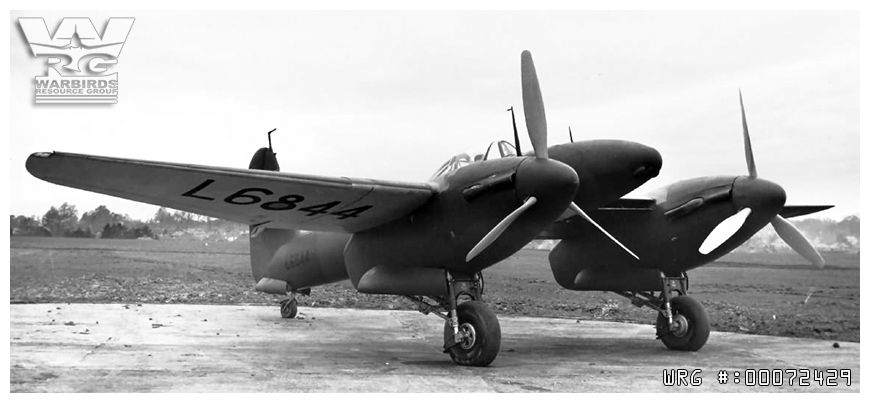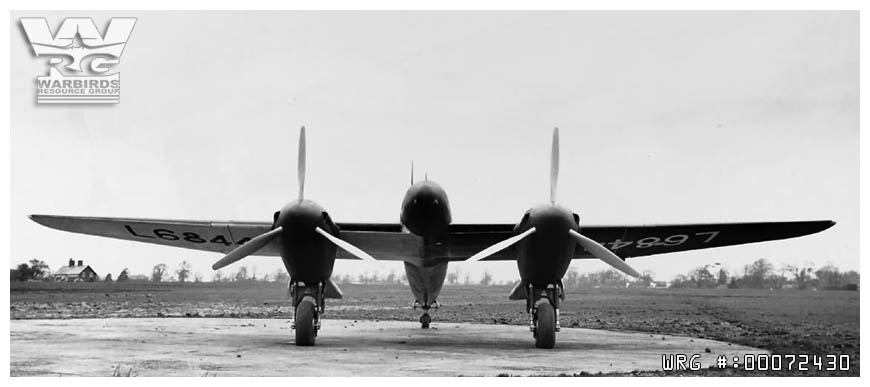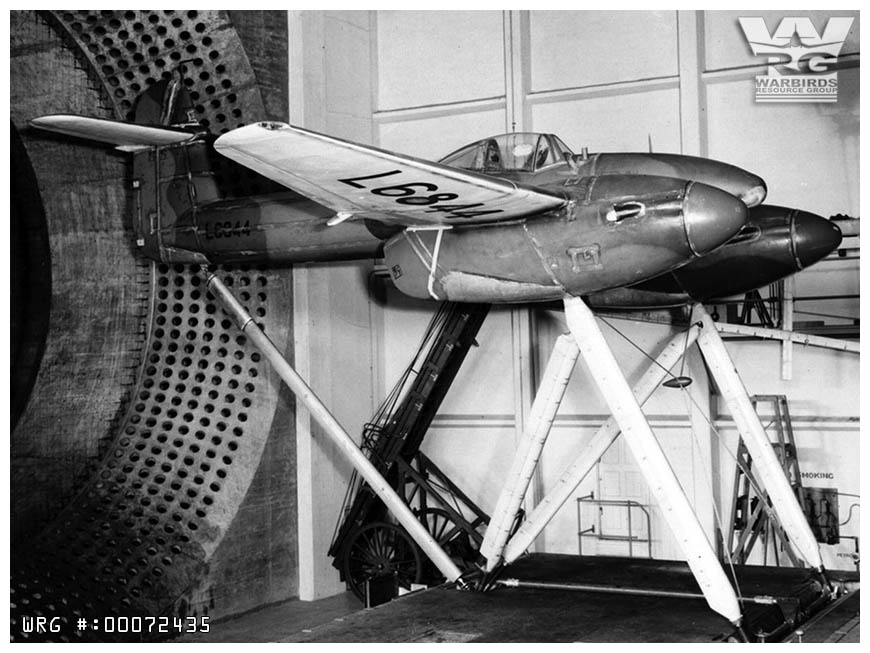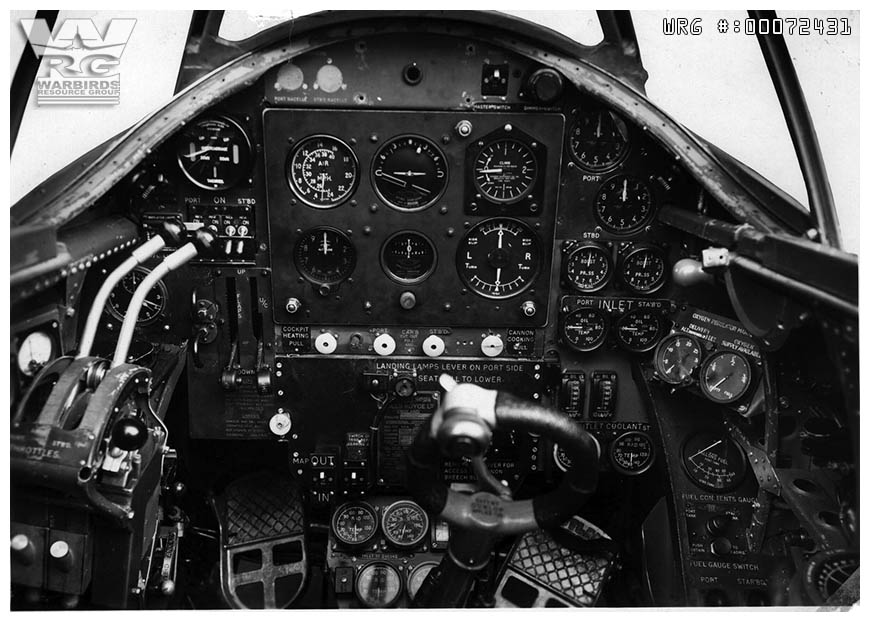Originally posted by Mark AllenThe Westland Whirlwindby Philip J. R. Moyes
"Seldom, if ever, can a British aeroplane have been surrounded by so much "red tape" as was the West- land Whirlwind twin-engined monoplane. Designed to an Air Ministry Specification of 1935 (F .37 /35), it flew in October, 1938, and entered service in 1940, being the R.A.F.'s (and Westland's) first twin- engined single-seat fighter and the first such machine to be used in numbers by any of the great powers. For some time after the outbreak of the Second World War its existence was supposed to be a closely- guarded secret, but it was apparently no secret in France and Germany as early as 1938, for in that year drawings of the aircraft appeared in a French tech- nical paper. Lord Beaverbrook, the Minister of Aircraft Production, mentioned the Whirlwind by name in public in December, 1940-the same year in which it appeared in a German aircraft recognition handbook-but it was not officially disclosed by the Air Ministry until August, 1941, and details were not released to the press in this country until February, 1942.
The basic feature of the Whirlwind was its concentration of firepower: its four closely-grouped heavy cannon in the nose had a rate of fire of 600 Ib./ minute-which, until the introduction of the Beau- fighter (see Profile No. 137), placed it ahead of any other fighter in the world. Hand in hand with this dense fire-power went a first-rate speed and climb performance, excellent manouvrability and a fighting view hitherto unsurpassed. The Whirlwind was, in its day, faster than the Spitfire low down and, with lighter lateral control, was considered to be one of the nicest "twins" ever built.
The Whirlwind was designed by Mr. W. E. W. Petter-more recently of Canberra and Gnat fame- and his team to meet the requirements of Air Ministry Specification F .37 /35 for a single-seat day and night fighter. Design work began early in 1936, and although Bristol and Hawker also tendered, the Westland design was the one selected; it had the Westland-type number P.9 (P for Petter, incidentally) and an order for two prototypes was placed by the Air Ministty in February, 1937. The first prototype, L6844, first flew at Yeovil on 11th October, 1938, in the hands of Westland's chief test pilot, Harald Penrose. It proved to be faster than anything else, low down, hence its nickname "Crikey", inspired by a famous Shell advertisement of the day which depicted a laborer with a swivel neck seeing some- thing flash past him at a high rate of knots and trying to look in two directions simultaneously, exclaiming: "Crikey, that's Shell, that was!" This nickname was, apparently, first bestowed upon the Whirlwind by a local garage proprietor.
The Whirlwind was designed round two fully- supercharged Rolls-Royce Peregrine twelve-cylinder 'vee'-ty~e engines, the deliberate concentration of fire-power and the desire to give the pilot the best possible view being mainly responsible for its twin- engine configuration. It was completely orthodox in layout and construction (all-metal stressed skin) yet in many ways it was ahead of its time. Leading edge cooling ducts (for radiators which were enclosed in the center section), thin wing, hightailplane, extruded
spars, extensive use of elektron and castings, were typical features with which Westland's design team led the way. The "almost-bubble" one-piece canopy was another excellent innovation.
A peculiarity of the Whirlwind's control system was the fact that its two-piece rudder was concave or "hollow-ground" on both sides, the reason being that the original normally-contoured rudder was found to be very light and virtually ineffective over the first five degrees of travel either way. The adoption of a rudder with a re-entrant section overcame the problem. For reasons of control layout and nothing to do with aerodynamics, the rudder hinge was offset, and to compensate for this the rudder-section was made assymetrical port and starboard. On the upper part this was achieved by making just the starboard side hollow-ground. Another peculiarity was that part of the one-piece, high-lift Fowler trailing edge flap which stretched from aileron to aileron (it was hinged at the rear extremities of the engine nacelles which moved with it) also performed part of the function of radiator flaps, and in order to maintain a reasonably low coolant temperature, it was necessary 'to climb with it partly extended. If any serious delay was experienced before take-off, two fountains of steam appeared, necessitating shutting down both engines to cool off before taxiing.
Mention has already been made of the positioning of the Whirlwind's coolant radiators in the leading edge of the wing; this not only resulted in a clean- looking and low-drag installation but, because of the radiator ducts' close proximity, it also enabled the Whirlwind's cockpit to be heated at all altitudes. Another unusual idea was the original one of running the engine exhaust pipes through the wing fuel tanks. A trial installation was made in one aircraft and during tests Harald Penrose encountered fire in the air for the third time during his career. Flames burned through the rear spar and severed the aileron controls. The ailerons were of the Frise type, and as the balance area forward of the hinge line got into the slipstream the loose aileron went hard up against the stops. To counteract this, Penrose put up the opposite aileron to the same angle and came home on rudder and engines only.
From the flying viewpoint, the Whirlwind was considered magnificent, its sole peculiarity being its tendency to develop tail shudder in really tight turns because its rudder too easily assumed rhythmic oscillations. Handley Page slats of large area were fitted to the Whirlwind's outer wings but eventually, on production aircraft, they were locked shut for structural reasons, since at least one accident was believed attributable to a slat failure. Even then, lateral behavior at the stall was entirely adequate without their aid. The project design originally was planned to have twin fins and rudders, but in wind tunnel model tests it was found that the underslung engine nacelles caused turbulence troubles, and so the high tailplane layout was eventually adopted. There is interest in noting that consideration was given at one stage to "bending" the rear fuselage upwards, thus placing the tailplane even higher and in still calmer air.
As related earlier the first prototype Whirlwind, L6844, first flew on 11th October, 1938. On the last day of that year it was delivered to the Royal Aircraft
Establishment, Farnborough, and apparently it performed so well in tests that before the end of January, 1939, the Air Ministry placed a production order for 200 Whirlwinds with the first delivery promised for the following September. Shortly before the outbreak of war an additional order for 200 Whirlwinds was placed.
In May, 1939, the new "hush-hush" fighter was demonstrated to a party of M.P.'s at Northolt and in the words of one magazine report:
"the 'fastest time of the day' was not put up by the Spitfire , but by a secret twin- engined machine which streaked over from the west".
For reasons which will be dealt with later, Whirlwind production fell badly behind schedule and it was not until May, 1940, that the "first off", P6966. was ready to fly, the second prototype, L6845, being completed almost simultaneously. First deliveries-P6966 and P6967-were made on 3rd June, 1940, to No. 25(F) Squadron at North Weald, this unit (which was then flying Blenheim IFs) having had a pre-view of the Whirlwind two days previously when L6845 had been flight-demonstrated at North Weald. This proved to be a false start, however, and owing to a change in re-equipment policy, the new machines were re- allocated to No. 263(F) Squadron which had recently won immortality while flying Gladiators in Norway (see Profile No. 98).
The squadron was scheduled to re-form at Grangemouth, Stirlingshire, in June, but owing to teething troubles suffered by the ex-25 Squadron machines, it was July before No. 263 was re-formed-at Drem-and then with Hurricanes as temporary equipment. The first of No. 263's Whirlwinds arrived at Drem on 6th July, flown by the C.O., Squadron Leader H. Eeles, and two more followed on the 19th. On 7th August came the first write-off after P6966 (Pilot Officer McDermott) had a tyre burst on take-off. The Whirlwind was a touchy aircraft on take-off at the best of times, and in this particular instance the pilot was lucky; for despite the fact that his aircraft swerved, the nose did not touch the ground and he was able to get it airborne. While trying to retract the wheels McDermott learned from flying control that the undercarriage was visibly damaged and was warned that a landing would be hazardous. He climbed and baled out. The Whirlwind went thirty feet deep into the ground north of Stirling and McDermott made a safe landing only to be made prisoner by the local Home Guard!
Deliveries of Whirlwinds to No. 263 Squadron were held up by a lack of engines and only eight Whirlwinds were in service by October, 1940. The squadron moved to Exeter at the beginning of December and became operational on Whirlwinds on 7th December, flying 30 sorties before the month ended. So deplorable was the condition of the airfield surface at Exeter, however, that early in the New Year an operational flight was detached to St. Eval. The squadron's first action came on 12th January, 1941, when Pilot Officer Stein and Sergeant Mason, on standby duty, were detailed to intercept a returning German bomber. Stein intercepted the "bandit" some forty miles south-west of the Scillies and following his attack, No. 263 was credited with 'one Ju 88 damaged'. In February the squadron gained its first confirmed victory with Whirlwind aircraft when Flying Officer Hughes and Pilot Officer Graham (who was missing after the en- counter and assumed to have been shot down) destroyed an Arado 196 south of Dodman Point. Westland sent the squadron a case of champagne with which to celebrate the victory.
Following an attack by the Luftwaffe on St. Eval in the middle of March when nine of No. 263's twelve Whirlwinds were damaged on the ground, the entire squadron moved to Portreath, but on 10th April it moved again, this time to Filton (Bristol). During the first four months of 1941 the squadron lost many pilots through flying accidents, and three in action.
Convoy patrols were undertaken by the Whirlwinds during May and on 14th June six aircraft took part in the first Warhead operation-code-name for low-level strikes against airfields in the Cherbourg Peninsula, the purpose of which was to destroy enemy aircraft on the ground. The Whirlwinds operated from Ibsley on this particular occasion, but owing to ground mist at the selected targets-Maupertuis and Quer- queville-the main strike was centred on tarpaulin- covered equipment. This operation marked the start of the Whirlwind's career as a ground-strafing aircraft. On 7th August No. 263 moved to Charmy Down and five days later it provided close escort, as far as Antwerp, for 54 Blenheims of No.2 Group making a daylight raid on power stations near Cologne. During the same month, the squadron flew many offensive sorties-mainly against airfields at Quer- queville, Maupertuis and Lannion-as a result of which three Ju 88's, at least eight Ju 87's and some Bf 109's were destroyed on the ground, one E-boat sunk and another damaged. On one occasion four Whirlwinds were intercepted by twenty Bf 109's while engaged on a Warhead sortie and a fierce dog fight ensued. Although outnumbered 5 to 1, the Whirlwinds gave a good account of themselves and destroyed two of the enemy. Two Whirlwinds were damaged and a third force-landed when returning to base. All this led the squadron diarist to record: "The Whirlwind has at long last been completely justified and vindicated, having shown that it is an admirable machine for ground strafing and also that it is a match for the Me.109s". While this may have been true low down, it was not so at altitudes, where, through changing tactics, the majority of combats were taking place.
What the Whirlwind urgently needed was an improved mark of Peregrine, but Rolls-Royce were heavily committed to Merlin production and development at this time, and were disinclined to spare the effort to improve the Peregrine's performance. At some stage the Air Ministry and the Ministry of Aircraft Production apparently discussed the idea of re-engining the Whirlwind but rejected the idea of giving it a new lease of life in this way because they considered "its fuselage was too small and its entire layout unpromising".. Thus it was that the Whirlwind's lack of altitude performance reduced its effectiveness as a weapon of war and, in turn, restricted its operational career. Another contributory cause, again mentioned in an official volume is that "at a time i.e. 1938, when nearly all types were being ordered 'off the drawing board', the Air Staff required the Whirlwind prototype to complete brief handling trials before the production order was given to the firm. Its development period was thereby considerably ******ed with the result that when it did come into service it had missed its operational opportunity (as a heavy-armed interceptor) and was never able to catch up the time it had lost".
PRODUCTION CUT-BACK The second production order for 200 Whirlwinds which had been placed in mid-1939 was cancelled in 1940 and the initial order for a similar quantity was reduced to 114 aircraft. The last of these left the assembly line in January 1942.
At the end of 1941, No. 263 Squadron was at Colerne, having been based successively at Martle- sham Heath, Wattisham and Predannack. Meanwhile another Whirlwind squadron had formed on 20th September, 1941-No. 137 at Colerne, moving soon afterwards to Charmy Down, and No. 263 had assisted its formation by contributing pilots and other personnel. On 12th February, 1942, No. 137 Squadron, by now based at Matlask (and having previously operated from Charmy Down, Predannack and Coltishall, in turn) took part in the famous "Channel dash" episode and in doing so lost four aircraft in a dog fight with twenty Bf 109's.
The ensuing months saw the Whirlwind squadrons engaged in convoy patrols and Rhubarbs (massive fighter sweeps over Northern France and the Low Countries), in which targets ranged from railway locomotives to oil refineries, and-over sea-from E-boats to minesweepers and even a lighthouse. Another activity was night-flying training. During this period the squadrons each saw several changes of location.
In the latter part of 1942 the Whirlwind was adapted as a bomber and subsequently joined the Hurribomber in attacking the enemy in occupied territory with cannon and bombs by both day and night. One 250 or 500 lb. bomb was carried beneath each wing, and thus modified the Whirlwinds were unofficially known as "Whirlibombers". The fitting of bomb racks to the Whirlwind was advocated in September, 1941, by Squadron Leader T. Pugh, D.F.C., the C.O. of No. 263 Squadron, but it was not until 21st July, 1942, that the first of the squadron's Whirlwinds was modified to carry bombs. The first "Whirlibomber" operation-by No. 263 Squadron and only intended as a trial run-took place on 9th September, 1942, when two sections, escorted by Spitfires, attacked four armed trawlers steaming from Cap de la Hague, near Cherbourg, towards Alderney.
Success was immediate-two of the trawlers were sunk. No bomb sight was used in such operations, and as the Whirlwinds invariably bombed from 50 feet or less, a delayed action generally fuse was chosen. When loaded with bombs the aircraft flew left wing low in a dive and at high speed aileron snatch was experienced. It was recommended that both bombs be dropped simultaneously during low-level attacks, but if pilots wished to make two bombing runs then they were advised to drop the port bomb first.
The two Whirlwind squadrons continued to terrorize the enemy with bombs and cannon until the Typhoon took over the job in 1943. No. 263's hunting grounds were the Brest and Cherbourg Peninsulas and the Western Approaches, while No. 137, operating from Manston, covered the Channel and Northern France. Railway lines showed up well in the moon- light, smoke proclaiming the approach of a train. When "working on the railway", the Whirlwind's four 20 mm. Hispano cannon proved entirely satisfactory-in- deed one No. 137 Squadron pilot blew up four locos in a single sortie. In its first six months of fighter-bomber operations No. 137 Squadron destroyed or damaged thirty-seven goods trains, sixteen of them by night and the rest by day. By day only goods trains were attacked, but by night passenger trains were also considered fair game, for only Germans were permitted to travel by night in occupied territory. Enemy airfields also
"~ were a favorite target for low-level beat-ups by the "Whirli- bomber" boys.
Eleven Whirlwinds were subscribed for by war weapons funds, notably that organised by the wealthy British colony in South America and known as the Bellows Fellowship, whose object was to "raise the wind" for the purchase of aircraft for Britain. Each member had to contribute a centavo for every German aircraft shot down by the Fellowship's "own" aircraft, and membership grew to 70,000.
The Fellowship's Whirlwind gifts included P7094, which carried the word "Bellows" by the cockpit with a pair of bellows painted beneath it within an oval surround; P7055, P7116-P7121 inclusive, "Bellows Argentina Nos. 1-7" respectively and P7122 "Bellows Uruguay No.1". Another presentation aircraft, P7056, subscribed for by the people of its West Country birthplace, was named "Pride of Yeovil".
Some interesting experimental armament installations were made on the Whirlwind. The first prototype, â£6844, was fitted with twelve 0,303 in. Browning machine guns, while another Whirlwind mounted a single 37 mm. cannon. A high altitude photo-reconnaissance version of e Whirlwind was projected but did not materialize."
SPECIFICATIONS
Wings: Low wing cantilever monoplane. All-metal structure with light alloy stressed skin covering. Metal-framed fabric- covered ailerons. Fowlertype trailing-edge flaps on centre section between ailerons and fuselage. Rear part of engine nacelles hinged to move with the flaps to which they were attached. Handley Page anti-stall slats fitted to leading edge of outer wing panels.
Fuselage:
Oval section metal monocoque structure with stressed- skin
covering. Tail Unit: All-metal structure with stressed-skin covered fixed surfaces and fabric-covered movable surfaces. Cantilever tailplane mounted high up fin with acorn-type fairing at intersection of two surfaces. Divided rudder and elevators.
Undercarriage:
Backwards-retracting type, main wheels being completely enclosed by hinged doors. when raised into engine nacelles. Fully-retractable tailwheel.
Powerplant:
Two Rolls-Royce Peregrine I 12 cylinder vee liquid-cooled geared and supercharged engines, each developing 885 h.p. at 3,000 r.p.m. at 16,250 ft.; 860 h.p. at 2,850 r.p.m. at 13,500 ft., and 765 h.p. at 3,000 r.p.m. at sea-level with 87 octane fuel. Three-bladed
de Havilland D.H.4/4 variable pitch, constant speed airscrews of
10 ft. 0 in. diameter.
Armament: 'Four fixed 20mm. Hispano Mk. 1 cannon (Oerlikon design and Hispano licence) in nose, each with a magazine containing 60 rounds of ammunition and giving a rate of fire of 600 tb./minute.
Provision made in service for two Mk. III Universal bomb-carriers, one under each wing, for 2x250 or 2x500 lb. bombs.
Dimensions:
Span 45ft. 0 in. Length (overall) 32 ft. 3 in., (tail down) 321t in.' Height (tail down) 10 ft. 6 in. Track 12ft. 9 in. Wing area 250 sq. ft.
Weights:
Empty 8,310 lb. Loaded as fighter 10,356 lb.
Loaded as bomber, 10,8881b. with 2x250 lb. bombs,
11,388 lb. with 2x500 lb. bombs.
Performance:Max. speed (light): 315 m.p.h. at 5,000 ft.,
335 m.p.h. at 10,000 ft.,
360 m.p.h. at 15,000 ft.,
350 m.p.h. at 20,000 ft.
Max. speed (loaded): 304 m.p.h. at 1.5,000 ft. with full war load and racks,
278m.p.h. at 15,000 ft. with full war load and 2 X 250 lb. bombs, 270 m.p.h. at 15,000 ft. with full war load and 2 X 500 lb. bombs.

Westland Whirlwind first prototype L6844

Westland Whirlwind first prototype L6844

Whirlwind prototype L6844 undergoing wind tunnel tests, Farnborough, 1938

Westland Whirlwind cockpit

G-AGOI P7048 during her time with Westland as the Company plane.

The last surviving Westland Whirlwind which had been used as Westlands hack aircraft seen around 1948, just prior to its scrapping.






